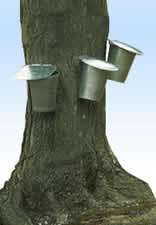
Dimdima
Online Children's Magazine from India

Dimdima
Online Children's Magazine from India
By Rani Iyer

On a cloudy windy and rainy day, Pat began to say how she missed home. “What is so special at home?” asked another friend as we waited for the bus.
“Fine weather for Maple syrup,” she said.
“Do you have many trees?” I asked.
“Sure, plenty.”
“It must be fun.”
“Plain hard work, trust me.”
“Does it taste like honey?” I asked.
“You have never tasted Maple syrup, have you?” she exclaimed in astonishment.
I turned shades of red. “I am taking her to taste some maple syrup,” she decided pushing me towards the eatery.
“Cold days are best for Maple syrup,” Pat explained as we walked, “In our farm, metal buckets hang on small drips from trees to collect the sap in winter. The sap looks like water, but tastes sweet.
”
“Does it have minerals besides sugar?” I asked.
“Sure. Scientists say that the sugar that is washed in the sap is made in summer the year before. The sugar made that summer is stored in the tree for winter.”
“Does it harm the tree?”
“We have been doing it for several generations on some trees.”
“Something like rubber sap,” I explained to Pat, as she had never seen a rubber tree. She was impressed by the similarity in the process. But making Maple syrup from sap is a hard job. The sap is heated to a boil in a large pan. It takes about 35 gallons of sap to make one gallon (about 4 litres) of maple syrup!
During cold nights, the maple trees freeze. The water rises into the trunk and branches of the tree and becomes frost inside tiny hollow spaces. In the morning, the frost melts and becomes sap, which flows down the tree.
“Wow! Who discovered it?” I asked.
“Actually it was discovered by Iroquois Indian chief named Woksis,” she replied.
By now, we had pancakes and a bottle of syrup to pour on the top of it. Pat watched my face, as I tasted it. “How is it?” she asked anxiously.
“Pat, next time I will treat you to sugar cane. This is almost as good as that!”
Last updated on :5/31/2004
EXPLORE MORE...
COMMENT ON THIS ARTICLE
Wants to share something related to this article? Please use the form below.
Dimdima is the Sanskrit word for ‘drumbeat’. In olden days, victory in battle was heralded by the beat of drums or any important news to be conveyed to the people used to be accompanied with drumbeats.
Bharatiya Vidya Bhavan
K. M Munshi Marg,
Chowpatty, Mumbai - 400 007
email : editor@dimdima.com
Bharatiya Vidya Bhavan
505, Sane Guruji Marg,
Tardeo, Mumbai - 400 034
email : promo@dimdima.com
Dimdima.com, the Children's Website of Bharatiya Vidya Bhavan launched in 2000 and came out with a Printed version of Dimdima Magazine in 2004. At present the Printed Version have more than 35,000 subscribers from India and Abroad.